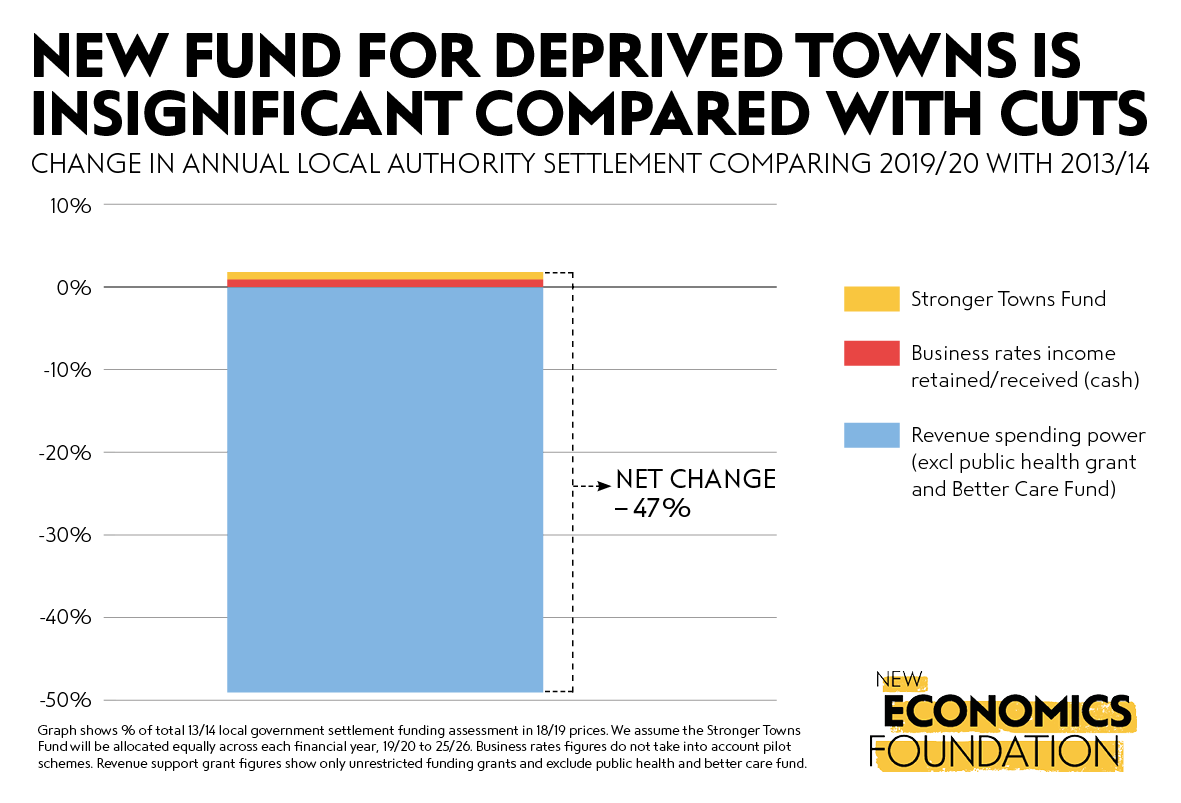Deprived towns fund is insignificant compared with staggering cuts
Reversing the damage done by austerity will take more than this paltry offer
05 March 2019
The Stronger Towns Fund, announced by the government yesterday, is a £1.6 billion fund to be spent between now and 2025 on places that are often referred to as ‘left behind’.
£1.6 billion as a lump sum is not to be sniffed at, even though in government spending terms it’s relatively small beer. Share small beer out over seven years and it’s reduced to a thimble full; around £267 million total per year if spending starts in the financial year 2019/20 and is distributed evenly until 2025/26. Share it out further to all the places in the UK that most need government investment, training and jobs and it’s a droplet in the ocean.
If that were the beginning and end of it, then fine. ‘Government announces small bit of funding for something that needs a bigger bit of funding’ is not much of a story. However, the government is giving with one hand, and taking much more away with the other.
The Revenue Support Grant is given to local authorities by central government and makes up around a third of councils’ budgets. Between 2018/19 and 2019/20, the grant is due to be cut by 37% — that’s £1.3 billion in a single year — on top of savage cuts to it that have already taken place.

From 2013/14 to 2019/20, even with locally retained business rates and the main government unrestricted grant, local authorities have seen their net incomes decrease by 48%. The year of Stronger Towns Funding that will presumably occur in 2019/20 (if allocated equally over six years) compensates this loss by less than 1%. Council incomes will still have been cut by 47%. The whole Stronger Towns pot of money would reduce this loss by no more than 5% if provided in one year — which will not be the case. Of course, some regions will receive more than this and others less, but compared to the staggering cuts to local authorities, the new fund pales in comparison.
Aside from this loss of government money, post-Brexit the UK will be losing money provided by the European Union via its structural funds. Between 2014 and 2020, the UK will have received €17.2 billion for regional and social development, which has flowed significantly to many of the same areas that the Stronger Towns Fund will prioritise.
If the UK were to remain in the EU, between 2021 and 2027, €13 billion of EU structural funds would flow to poorer regions; significantly more than the Stronger Towns Fund. Some further settlement is expected from central government to compensate areas for this loss, but the amount is still unclear.
The Stronger Towns Fund has not gone down well in many of the regions, smaller cities and towns at which it will be targeted. And why should it? One cause of the economic malaise many of these places face is austerity. Reversing its effect will take more than this paltry offer. It will take a transformational approach to government investment, focused both on rebalancing the economy and restoring basic public services that are often the lifeblood of communities.
Many, including opposition politicians, have suggested that the Stronger Towns Fund looks like a bribe to persuade Labour MPs in leave-voting constituencies in particular to support the government’s Withdrawal Agreement. If so, the chances are it will have the opposite effect
Notes
- Comparing local authority financing over time is complex because not all grants are directly comparable and local authorities have been handed increasing statutory responsibilities. Therefore we simply compare two major sources of revenue — unrestricted grant funding in the form of revenue support grants, and business rates baseline funding. Together these form what is known as the settlement funding assessment. This presents an underestimate of cuts and should be taken as a minimum of the cuts local authorities have faced.
- We compare to 2013/14 as there was a major overhaul of government financing in this year, where local governments were allowed to retain a proportion of business rates collected as well as a portion of the growth in their rates over time, rather than business rates being fully collected centrally and redistributed.Graph shows % of total 2013/14 local government settlement funding assessment in 2018/19 prices
- We assume the Stronger Towns Fund will be allocated equally across each financial year, 2019/20 to 2025/26
- Business rates figures do not take into account pilot schemes
- Revenue support grant figures show only unrestricted funding grants and exclude public health and the better care fund
Image: Nootch (CC BY-NC-ND 2.0)
Topics Brexit Local economies






